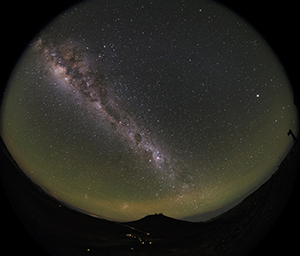
Contact Us
Institutional Communications
Bureau of Mines Building, Room 137
Laramie, WY 82071
Phone: (307) 766-2929
Email: cbaldwin@uwyo.edu
UW Planetarium to Highlight Beauty of Night Sky During August Shows
Published July 30, 2019

The band of the Milky Way galaxy is seen rising over European Southern Observatory’s
(ESO) Very Large Telescope (VLT) located in the Atacama Desert in Chile. Observatories
like the VLT and the Wyoming Infrared Observatory allow stargazers to study the night
sky in great depth. (ESO/Babak Tafreshi Photo)
The beauty of the night sky will be the focus of the August schedule at the University of Wyoming Harry C. Vaughan Planetarium.
“During August, we will explore the planets, stars, nebulae and galaxies that make the night sky beautiful,” says Jordan Turner, the planetarium’s interim coordinator. “Come and learn about the lives of stars, how they light up our universe and how you are made from stars. And don’t miss rocking out with Metallica in our new laser Metallica show.”
Friday night shows start at 8 p.m., and STAR Observatory star parties run from 8:30-9:30 p.m. Kid-themed planetarium shows are Saturdays at 11 a.m. The month also includes four Tuesday night shows; they begin at 7 p.m.
Tickets are $3 for students and $4 for nonstudents. Tickets can be purchased at the Department of Physics and Astronomy main office, located in Room 204 of the Physical Sciences Building, Monday through Thursday, from 8 a.m.-4:30 p.m., and Friday from 8 a.m.-noon. Tickets also can be purchased by going online at http://wyomingspacegrant.org/planetarium/shows/ and clicking on “Purchase tickets online with a credit card.” Doors open 20 minutes before the show, where tickets will be sold if available. The planetarium, which seats 58, is located in the basement of the Physical Sciences Building.
The August planetarium schedule is as follows:
-- “Dust, Light, Dust,” Friday, Aug. 2, 8 p.m. Although stars aren’t alive, they are born, go through a metamorphosis and die much like a butterfly. Visitors can learn about the science behind the formation of stars, the various forms they take and their life cycle.
The STAR Observatory on the rooftop of the Physical Sciences Building will be open to the public for a “star party” from 8:30-9:30 p.m. Weather permitting, telescopes will be set up to peer into the evening sky.
-- “This Month’s Sky,” Tuesday, Aug. 6, 7 p.m. August provides the perfect weather to look for meteor showers, Venus at its brightest and Mercury in the morning, just before sunrise.
-- “You Are a Star,” Friday, Aug. 9, 8 p.m. This program tracks energy and matter throughout all of time and space to trace it right to you. Discover how and why you are a star.
-- “Space is Art,” Saturday, Aug. 10, 11 a.m. For many years, people have looked up into the sky and have been inspired by the magnificent things they’ve seen there. This program will look at some of the incredible art that has come about, thanks to space.
-- Laser show, Saturday, Aug. 10, 8 p.m. Visitors can rock out with music by Metallica, while images and graphics are projected on the planetarium dome. Snacks and drinks will be provided.
-- Full-dome movie double feature: “Mayan and Mexica Archaeoastronomy,” Tuesday, Aug. 13, 7 p.m. “Mayan Archaeoastronomy: Observers of the Universe” takes viewers into a Mayan world of knowledge about the importance of the orientations of its temples in relation to the movement of some stars. Through immersive scenarios, “Mexica Archaeoastronomy: Between Space and Time” illustrates the important role played by astronomical observation for the evolution of pre-Hispanic cultures in central Mexico.
-- “The Search for Terra Nova,” Friday, Aug. 16, 8 p.m. This program discusses the science and history behind detecting exoplanets; the knowledge that has been gathered so far; and the possibility of extending mankind’s reach to the stars.
The STAR Observatory on the rooftop of the Physical Sciences Building will be open to the public for a “star party” from 8:30-9:30 p.m. Weather permitting, telescopes will be set up to peer into the evening sky.
-- Full-dome movie: “Dawn of the Space Age,” Tuesday, Aug. 20, 7 p.m. From the launch of the first artificial satellite, Sputnik, to the magnificent lunar landings and privately operated space flights, visitors will be immersed in this historic reconstruction of man’s first steps into space.
-- “Constellations Across Cultures,” Friday, Aug. 23, 8 p.m. This program will offer a detailed look at the constellations that are known and loved, and how they are depicted differently across different cultures.
-- “A Special Star,” Saturday, Aug. 24, 11 a.m. This program explores why the sun is such a special star.
-- Laser show, Saturday, Aug. 24, 8 p.m. Visitors can rock out with music by Metallica, while images and graphics are projected on the planetarium dome. Snacks and drinks will be provided.
-- Full-dome movie double feature: “Mayan and Mexica Archaeoastronomy,” Tuesday, Aug. 27, 7 p.m. “Mayan Archaeoastronomy: Observers of the Universe” takes viewers into a Mayan world of knowledge about the importance of the orientations of its temples in relation to the movement of some stars. Through immersive scenarios, “Mexica Archaeoastronomy: Between Space and Time” illustrates the important role played by astronomical observation for the evolution of pre-Hispanic cultures in central Mexico.
-- “Brilliant Horizons,” Friday, Aug. 30, 8 p.m. Light, in the form of electromagnetic radiation, is how people experience and learn about the universe. This program explores the farthest and closest reaches of the universe.
Contact Us
Institutional Communications
Bureau of Mines Building, Room 137
Laramie, WY 82071
Phone: (307) 766-2929
Email: cbaldwin@uwyo.edu
